Morozov
A.N.
Lecture 8. Deposits
of moisture in soil and types of soil moistening.
Ageless
truths, whereas they are ageless, nevertheless they are needed to be reminded
and confirmed. |
Gandhi |
There
are many ways of accumulation, saving and recharging of soil moisture. To understand
where and how moisture could be saved and about the right way of moisture recharging,
first of all, let us tell a little on capacities of soil forming materials and
of soil to leak and hold moisture
Let us start from the consideration - how
moisture is hold in soils which are wetted by ground waters and underground waters
(pore waters of first level from soil surface are accepted as ground waters).
For simplicity we shall consider relatively
homogeneous by layers soils.
If ground waters
occurrence is stable at significant depth and slightly impact to vital processes
of upper active layer - such conditions are accepted to call as automorphous.
They usually are found at well drained river valleys and in piedmont areas, and
also deep from water sources in steppes and deserts, but there, when they have
irrational irrigation, they turn into hydromorphous, inasmuch as ground water
sideward drain capabilities are very poor.
Moisture content is significantly
changed depthward only at upper layer. We can see at Picture 8.1 that upper layer's
moisture is changing only seasonably, but when it is deeper then it is remained
stable.
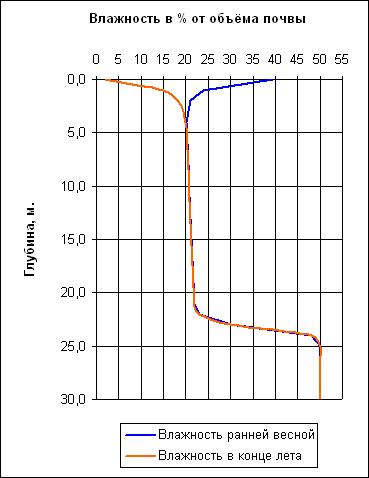
Picture
8.1. Diagram of moisture for soil and underground layers where stable deep ground
water table takes place. (it is 25 m at this picture).
So called "capillary
fringe" is clearly seen at the picture over ground water table, i.e. zone
of excessive humidity, and upper of it up to soil drying up zone (from 22 down
to 3m from soil surface) - relatively constant moisture close to "field moisture
capacity" is remained.
However, it does
not mean at all, that there is no movement of moisture in this layer. For instance,
it was theoretically proved and field-proven instrumentally that many fresh water
lenses in sandy deserts come to existence at depth of 20-30 m and they are recharged
from the upper horizon wetted with miserable precipitation (it is easier to measure
and prove at sands than at other bedrocks, though the processes taking place thereat
are the same.
Sometimes, very seldom, at arid
regions, the occurrences are observed, when between soil and ground water may
be found very dry horizons which have moisture only a little bit more than maximal
hygroscopic moisture. These horizons are saturated very slowly in the first several
years, but if they are wetted…then ground waters arise at a fast clip to soil
surface.
How could moisture reach 20-30 m depth almost without changing of
moisture of intermediate horizons? "The secret" was opened by scientist
A.F.Lebedev as early as thirties of previous century and after that, the rest,
was "paperwork" - to find out that he was right. The point is that if
moisture is not moving in the soil then it means that it is in equilibrium with
bedrock (i.e. gravity forces acting on the water are balanced by cohesion forces
with the soil).
If moisture weight starts
to exceed the bedrock holding force then its excesses immediately begin flow down
("slip" would be more correct expression in this case) down to sublayer.
But, please, pay attention, it was also in equilibrium and superfluous moisture
in it causes the same impact. And, what's going down? When small amount of superfluous
moisture was added to upper horizon, but the whole water column down to ground
water made a move!
And this phenomenon discovered A.F. Lebedev and he called
it as "capillary discharging. It could be imagined very much demonstrably
with using billiard balls that put together in line. If first ball is stroked
slightly, then the last ball from another side will roll away! You can test it
yourself…
If amount of precipitation is enough
to supersaturate a little the upper layer of soil horizon which was dried before
to the condition over its equilibrium state, then very fast (anyway, during several
days), all surpluses will push on the moisture column (starting from the zone
beginning where moisture was in equilibrium condition down to ground waters) and
replenish ground water. And percentage of moisture in this zone is changing so
slightly thereat that it is too difficult to get sight of it.
Now it
is easy to understand which things takes place in such conditions if irrigation
rates will exceed holding capacity of the upper dried layer. Practice of irrigation
in Central Asia and in irrigation systems of Russia and Ukraine confirms incontrovertibly
that contrary to all predictions of the engineers that took into account only
losses for filtrations from lined canals, ground waters arise close to soil surface
in several years, cause waterlogging and salinization of lands.
It
should be also added, that apart from the described moisture moving in the form
of films, there is another mechanism of moisture moving, and that is moisture
in form of steam moving along free of water pores.
Update
mode of soil moisture during irrigation intervals for soils of medium textured
loamy grain-size classification was shown in more details at Picture 8.2. These
data were obtained at plots with open air with presence of vegetation cover, by
multiple determination of soil moisture in terms (in days starting from date of
irrigation) that were shown in the legend below the diagrams.
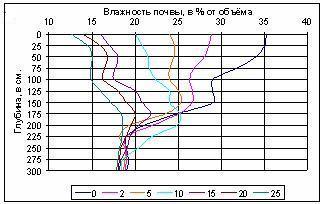
Picture.
8.2. Moisture mode of the moistness active changing zone at automorphous mode.
(Moisture mode during summer season of medium textured loamy soil in the period
starting date of irrigation up to 25 days after it).
As
it seen from Picture 8,2, the moisture active changing depth in automorphous conditions
is almost 200 cm for soils at medium textured loamy soil. Considering moisture
mode, we may conclude that as on 10-th day soil moisture at 1 m depth layer reaches
~22, 5 %, (when plants growth rate reduction (PGRR) is true to this type of substance
~20 %).
So, achievement of PGRR by 12…13 day development of PGRR should be
expected in such condition after previous irrigation.
Now,
let us consider soil moistness regime when we have ground waters persistently
close to surface, which directly impact to vital processes of upper active layer
and which is accepted to call as hydromorphous. This regime significantly is distinctive
from automorphous one in that ground waters permanently fed soil horizons because
the waters are close to root zone. Soil upper layers indwell in "capillary
fringe" zone in this case. Typical moisture content profile and of underlying
bedrocks in hydromorphous conditions along seasons are shown at Picture 8.3. Here,
upper soil layers pull moisture up from more moistened horizons as far as their
drying. Such soils are most provided with moisture from ground waters additionally
to precipitation in form of rain, snow and dew but… if the ground waters are fresh
and they are naturally well drained, but if there is no outflow there, then soils
are getting waterlogged and mineralized.
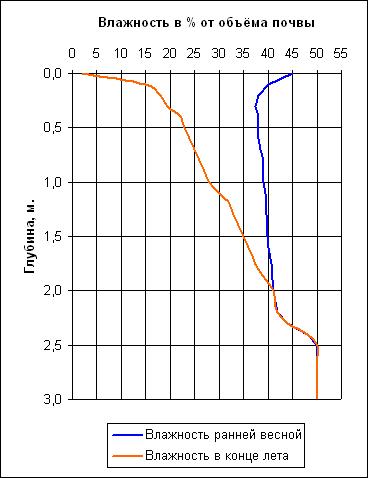
Picture
8.3. Moistness curve of soil and subsurface zone when stable close ground waters
take place.
Such lands most commonly are met in overflow lands, where
usually we may found fine meadows and wildwood (tugays). Here, it seems the Creator
himself provided conditions when soil should not be irrigated, or irrigated very
rarely, but wrong tillage result in to that upper layers stop with moistening
and the lands have to be irrigated in summer. Real mode of moistness for medium
loamy and sandy compositions for period of 25 days inclusively starting from irrigation
date was shown at Pictures 8.4 and 8.5.
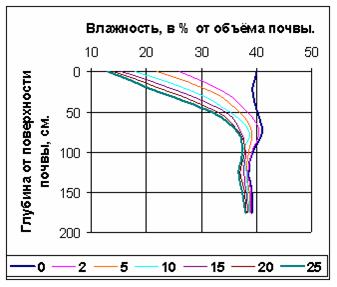
Picture
8.4. Observed moistness mode for medium loamy soil with having ground water table
at range between 100…150 cm.
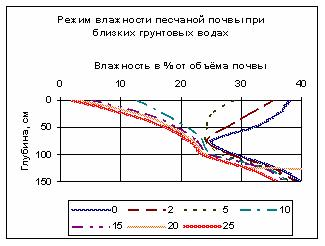
Picture
8.5. Observed moistness mode for sandy soil with having ground water table at
range between 100…150 cm.
Please, pay attention
that when close ground water table takes place then average moistness of 1 meter
layer at medium loamy soils never go below ~ 30 %, and moistness at sandy soils
- lower than 15 %. Moisture in the both cases is accessible for cultivated plants
Well,
at the beginning we told about how plants use solar energy to "pump moisture"
through themselves, then we analyzed how moisture is hold at automorphous and
hydromorphous soils, and now, in Lecture #9 we shall tell about interaction of
the whole this natural symbiosis. And if something is broken in that then the
whole mechanism may start to fail, or even completely fail.
Contacts with us

